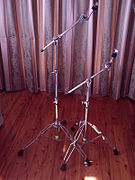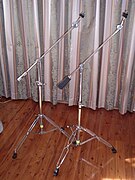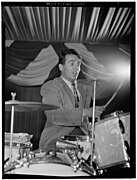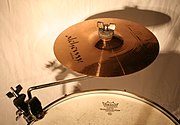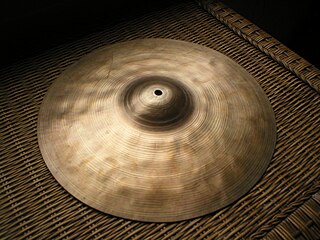
A cymbal is a common percussion instrument. Often used in pairs, cymbals consist of thin, normally round plates of various alloys. The majority of cymbals are of indefinite pitch, although small disc-shaped cymbals based on ancient designs sound a definite note. Cymbals are used in many ensembles ranging from the orchestra, percussion ensembles, jazz bands, heavy metal bands, and marching groups. Drum kits usually incorporate at least a crash, ride, or crash/ride, and a pair of hi-hat cymbals. A player of cymbals is known as a cymbalist.

A drum kit is a collection of drums, cymbals, and sometimes other auxiliary percussion instruments set up to be played by one person. The drummer typically holds a pair of matching drumsticks, and uses their feet to operate hi-hat and bass drum pedals.
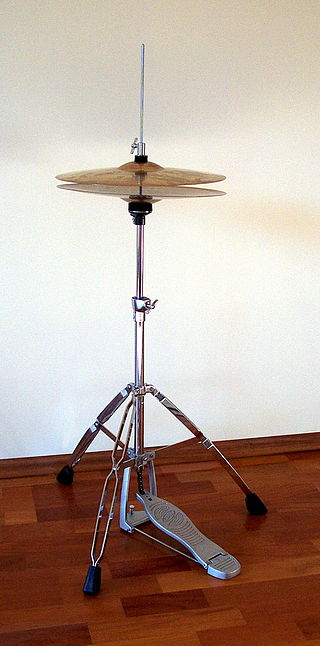
A hi-hat is a combination of two cymbals and a pedal, all mounted on a metal stand. It is a part of the standard drum kit used by drummers in many styles of music including rock, pop, jazz, and blues. Hi-hats consist of a matching pair of small to medium-sized cymbals mounted on a stand, with the two cymbals facing each other. The bottom cymbal is fixed and the top is mounted on a rod which moves the top cymbal toward the bottom one when the pedal is depressed.

The bass drum is a large drum that produces a note of low definite or indefinite pitch. The instrument is typically cylindrical, with the drum's diameter much greater than the drum's depth, with a struck head at both ends of the cylinder. The heads may be made of calfskin or plastic and there is normally a means of adjusting the tension either by threaded taps or by strings. Bass drums are built in a variety of sizes, but size does not dictate the volume produced by the drum. The pitch and the sound can vary much with different sizes, but the size is also chosen based on convenience and aesthetics. Bass drums are percussion instruments and vary in size and are used in several musical genres. Three major types of bass drums can be distinguished.

A floor tom or low tom is a double-headed tom-tom drum which usually stands on the floor on three legs. However, they can also be attached to a cymbal stand with a drum clamp, or supported by a rim mount. It is a cylindrical drum without snare wires, and tend to produce a booming, resonant sound which can vary in pitch.
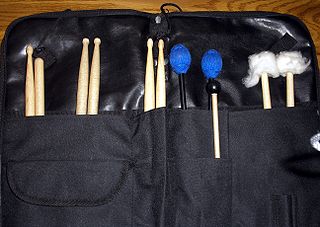
A percussion mallet or beater is an object used to strike or beat a percussion instrument in order to produce its sound.

Clash cymbals are cymbals played in matched pairs by holding one cymbal in each hand and striking the two together.

A suspended cymbal is any single cymbal played with a stick or beater rather than struck against another cymbal. Common abbreviations used are "sus. cym.," or "sus. cymb.".
In a drum kit, splash cymbals are the smallest accent cymbals. Splash cymbals and china cymbals are the main types of effects cymbals.
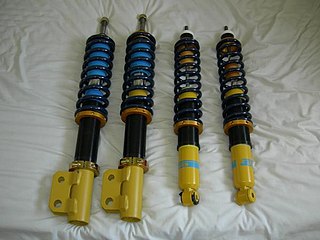
A coilover is an automobile suspension device. The name coilover is an abbreviation of "coil over shock absorber".

Electronic drums are a modern electronic musical instrument, primarily designed to serve as an alternative to an acoustic drum kit. Electronic drums consist of an electronic sound module which produces the synthesized or sampled percussion sounds and a set of pads, usually constructed in a shape to resemble drums and cymbals, which are equipped with electronic sensors to send an electronic signal to the sound module which outputs a sound. Like acoustic drums, the pads are struck by drum sticks and they are played in a similar manner to an acoustic drum kit, albeit with some differences in the drumming experience.
The term bicycle tools usually refers to specialty tools only used on bicycles, as opposed to general purpose mechanical tools such as spanners and hex wrenches. Various bicycle tools have evolved over the years into specialized tools for working on a bicycle. Modern bicycle shops will stock a large number of tools for working on different bicycle parts. This work can be performed by a trained bicycle mechanic, or for simple tasks, by the bicycle owner.

Pacific Drums and Percussion is a musical instrument brand established by the Drum Workshop Inc., in 1999, with the purpose of providing its percussion instruments at more affordable prices.

A microphone stand is a free-standing mount for a microphone. It allows the microphone to be positioned in the studio, on stage or on location without requiring a person to hold it.

Golf equipment encompasses the various items that are used to play the sport of golf. Types of equipment include the golf ball, golf clubs, and devices that aid in the sport.

Drum hardware is the set of parts of a drum or drum kit that are used to tension, position, and otherwise support the instruments themselves.
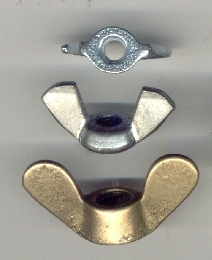
A wingnut, wing nut or butterfly nut is a type of nut with two large metal "wings", one on each side, so it can be easily tightened and loosened by hand without tools.

A nut is a type of fastener with a threaded hole. Nuts are almost always used in conjunction with a mating bolt to fasten multiple parts together. The two partners are kept together by a combination of their threads' friction, a slight stretching of the bolt, and compression of the parts to be held together.
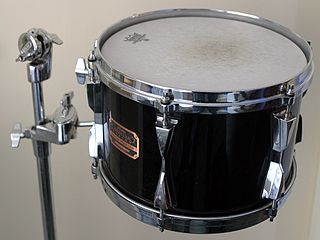
A tom drum is a cylindrical drum with no snares, named from the Anglo-Indian and Sinhala language. It was added to the drum kit in the early part of the 20th century. Most toms range in size between 6 and 20 inches in diameter, though floor toms can go as large as 24 inches (61 cm).







